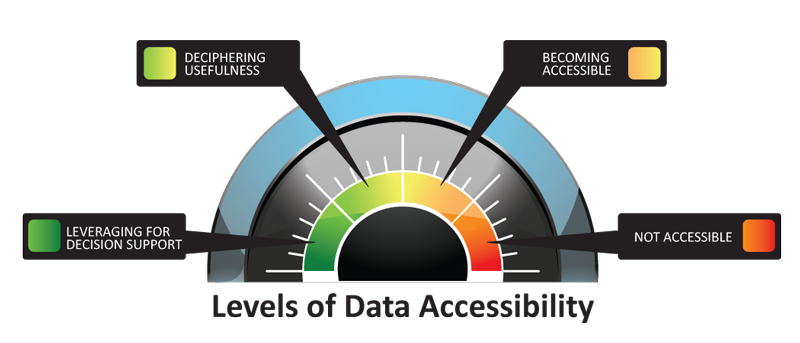At the HIMSS13 conference in New Orleans this week there is no short supply of factoids about the rate at which information is exploding. It is certainly true that in healthcare we have more access to data than ever before, but the industry’s access to information is a continuum. Some organizations are further along than others and some are moving at a faster pace.
All healthcare organizations are at some stage or straddling different stages along the following spectrum.
Data is not accessible
In most cases the data is there but is stored in different applications that are not able to exchange information with each other. Sometimes the data is siloed away in departments that view the data as “theirs” – stored in Excel files on individual computers or locked in file cabinets. It might even be that there isn’t prevailing thought within the organization around what data is important.
Data is becoming accessible
The idea that data belongs to everyone and should be accessible/transparent is gaining momentum across the country. While some health systems embrace this vision more than others, or have the resources to bring it about faster, many more applications are able to send information back and forth via feeds than a decade ago.
Deciding what data is actually useful
Access to large amounts of data can be overwhelming. A lot of data is simply that – a lot of data. Deciding what data is useful and being able to pull it and process it are the focus at this step. Dashboards come into the discussion now as organizations begin the process of trying to leverage their data.
Leveraging data for decision support
At this step data is no longer processed by analysts and delivered to end-users via reports or emails. Instead, meaningful, actionable data – data that end-users can view and then use to make informed, timely decisions – is in the hands of those on the front lines.
Obviously, the ability to use data to support individuals making good decisions in an efficient and timely manner should be the goal in healthcare today. Any information that can be used to help improve quality and/or lower costs must be in the hands of the those who can make it happen.
But data and technology are not the answers in and of themselves. Those who reach the pantheon of actionable data have invested a lot of time and resources to get there. If the appropriate strategies and processes are not in place to take advantage of the insight gained from the data the net result will not be worth the effort.
Effective strategies, appropriate processes, and a culture that values openness and communication are the necessary foundation on which to layer technology. Technology then is the vehicle to automate the strategies and processes that will enable data to be acted upon and make sustainable improvement a reality.
To learn more about how he help our clients use data to drive results email me at jackie.larson@avantas.com.


